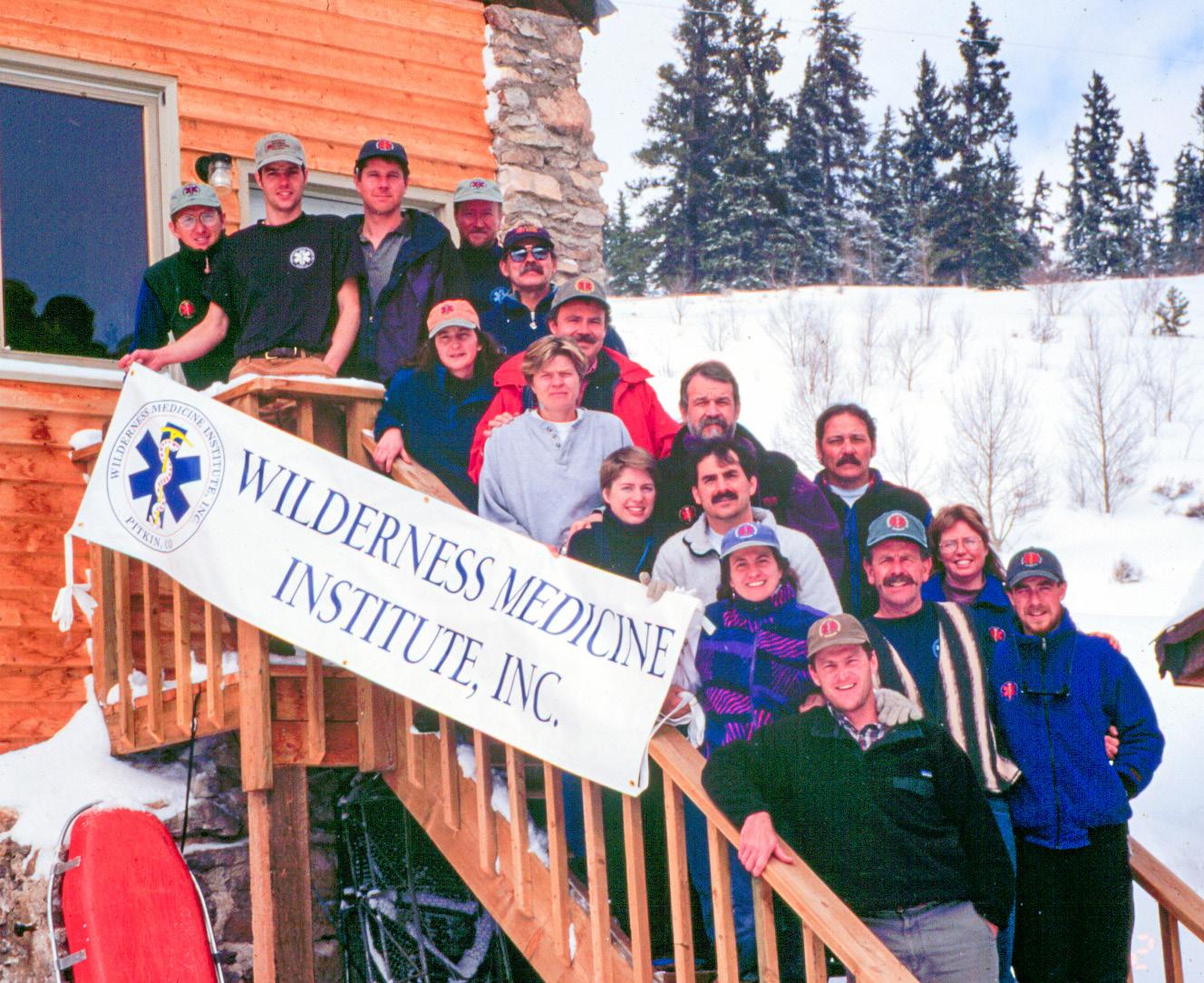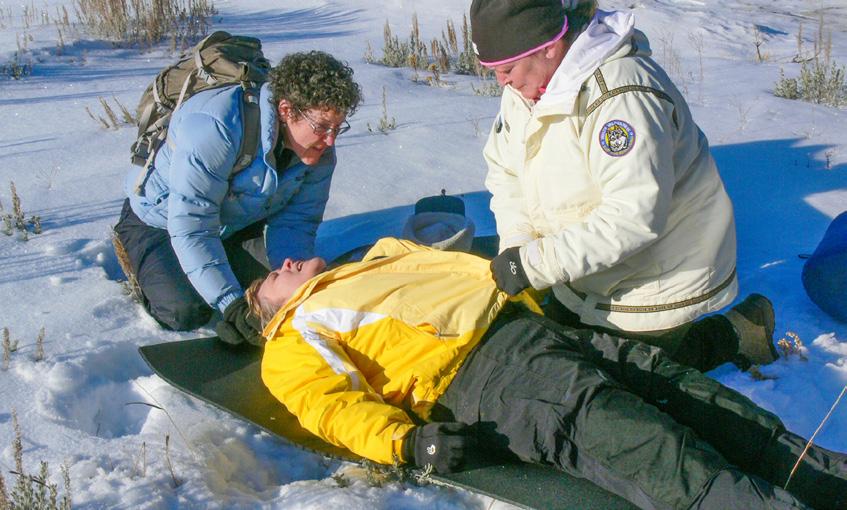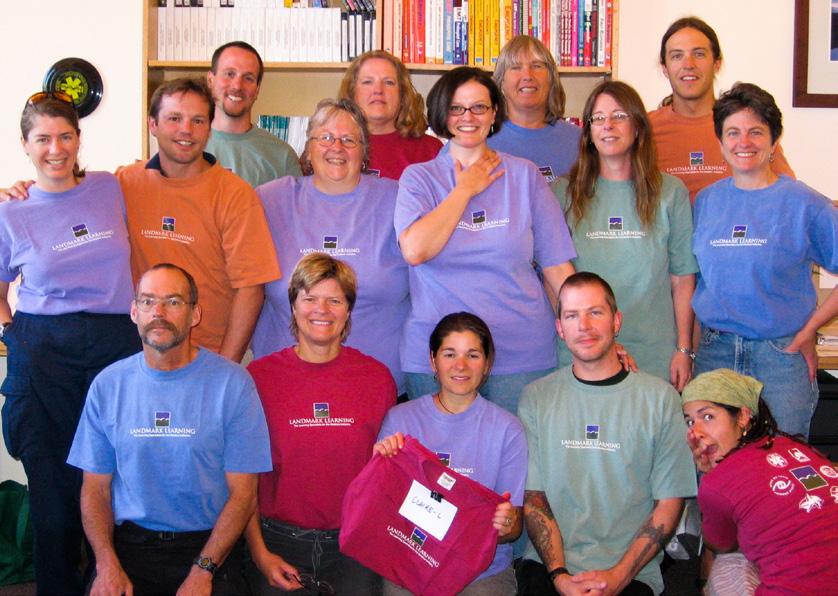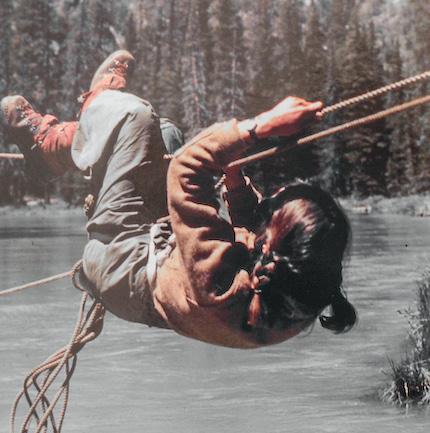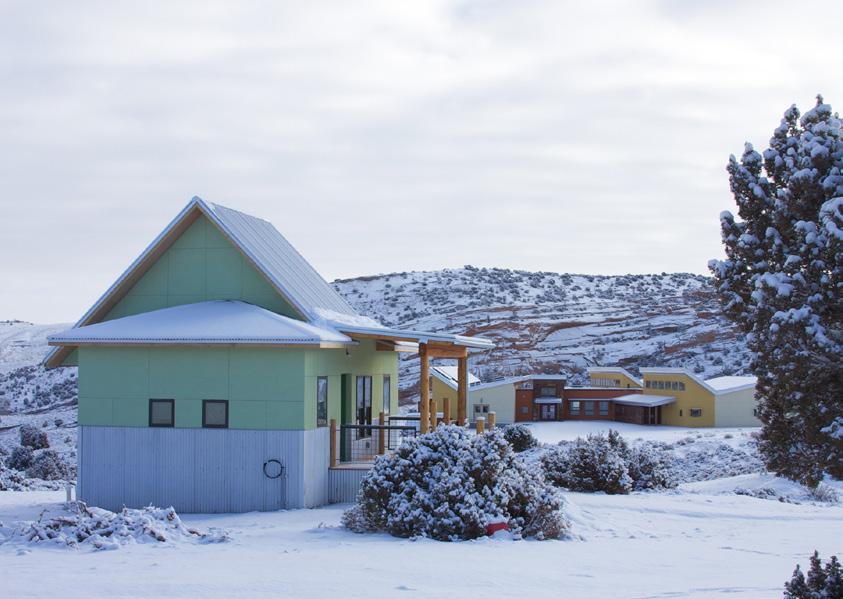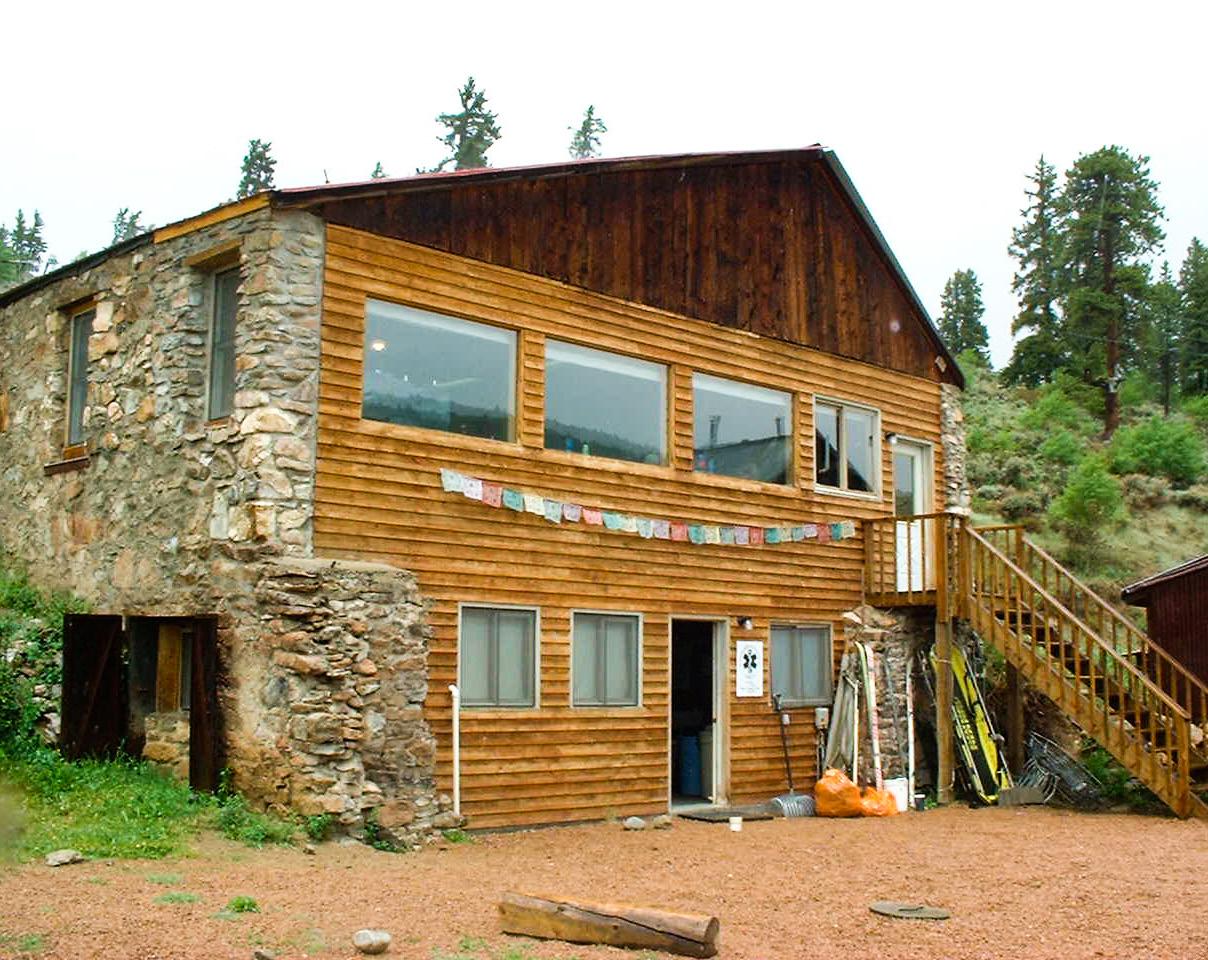
16 minute read
Cover Story | NOLS Anniversaries: 85 Combined

85 COMBINED YEARS OF LEADERSHIP


NOLS: Celebrating 55 Years of Wilderness Education and Leadership Training

By Anne McGowan NOLS Development Communications Coordinator With Reporting by Kate Dernocoeur
2020 has been a profoundly challenging year for most people, businesses, and organizations around the world, and NOLS is no exception. From mid-March, when we became aware of coronavirus and the majority of our employees were sent home, to the soon-to-follow shuttering of most campuses and the layoffs of many of those valued employees, NOLS locations around the globe felt the impact of this pandemic.
Still, we have much to celebrate as we mark NOLS’ 55th year and the 30th anniversary of NOLS Wilderness Medicine, as well as the joining of those two powerhouses in wilderness education under one banner 20 years ago. While we can’t gather to toast this high point, we can look back at our history and raise a glass (or maybe a Nalgene) to all who came along with us, learned with us, stumbled with us, and helped us get to this milestone. It’s been an extraordinary adventure and we’re glad you were on the trail with us. As origin stories go, NOLS—founded as the National Outdoor Leadership School—has a rich one. Fifty-five years ago, a charismatic, middle-aged mountain climber named Paul Petzoldt started the school from scratch, bent on instructing others how to teach mountaineering and leadership skills from a base outside the sleepy Rocky Mountain town of Lander, Wyoming.
Little did anyone guess—except perhaps Paul himself—that this motley outfit would go on to become the most respected outdoor school in the world, responsible for teaching leadership, wilderness skills and, soon, wilderness medicine to more than 320,000 students in the last five and a half decades.
Paul was already 57 years old in 1965, and had wide and deep experience in mountaineering, when he saw a need for an outdoor school that “taught the teachers.” He was also a “master scrounger” in the words of Kate Dernocoeur, the author of A Worthy Expedition: The History of NOLS, and, after plenty of planning, spent the spring of 1965 prepping for NOLS’ first course. Scabbing for gear and wool clothing (never cotton) at military surplus and thrift stores in the West and Midwest, Petzoldt was able to outfit the 43 young men who’d enrolled on that July expedition, before leading them into the Wind River Mountains.
With NOLS’ roots in mountaineering, lessons taught on that first course included climbing, hiking, shelter building, map reading, fishing and packing. When the course was


NOLS Wilderness Medicine: Celebrating 30 years, and 20 years with NOLS



By Ben Lester NOLS Wilderness Medicine Business Operations Manager With Reporting by Kate Dernocoeur
In 1990, two people moved to Pitkin, Colorado and opened a business. That was remarkable for two reasons: first, because the move raised the population of Pitkin (53 according to the 1990 Census) by nearly 4 percent. And second, because the business was dedicated to the teaching of a discipline called wilderness medicine.
That branch of medicine was still a new idea in 1990; it wasn’t really even defined until the mid 1970s, and in 1990 just a handful of folks were teaching it. Melissa Gray and Buck Tilton were among them, travelling around the eastern US in the mid and late 1980s teaching courses for New Hampshire-based SOLO—one of the first wilderness medicine schools in the world. In 1990, they decided there was an opportunity to expand the business, and relocated to Pitkin, where they founded the Wilderness Medicine Institute (WMI) with an arrangement that made them SOLO’s western affiliate. The very first program WMI ran was a 30-day EMT course down the hill from Pitkin in Gunnison, Colorado. That year, WMI trained 83 students on three courses.
Though wilderness medicine education was a new discipline in those days, other innovators were working towards a common goal. Tod Schimelpfenig, then NOLS Risk Management Director, had been teaching courses with a wilderness emphasis for NOLS expedition instructors since the late 1970s. He met Melissa and Buck around 1988 when he visited SOLO, in New Hampshire’s White Mountains. After WMI got off the ground in Pitkin, it was an easy decision to contract with Melissa and Buck to provide training for NOLS.
Tod gets a twinkle in his eyes remembering those e arly EMT courses in Lander. “We used the basement of the Noble Hotel for scenarios,” he said. “We could control the lights, and there were a lot of small spaces. We put a fogger down there to create smoke. If folks were doing well with the scenario, we’d switch the lights off and turn on some police sirens we’d found to really mess them up.”
One of the students on an early WMI course for NOLS was a new instructor named Terri Watson, who in 2019 was named NOLS President. “In the old days, first aid was all about memorization,” she remembered. The curriculum that WMI and other wilderness medicine schools taught was different because it emphasized principles and practice “and it taught you to think through real, complex situations.”
completed, those same instructors outfitted another group, and returned to the mountains two more times that summer.
With the help of many folks, including early instructor and military veteran Rob Hellyer and Petzoldt’s fellow U.S Army 10th Mountain Division member Tap Tapley, NOLS’ first season had been a success. Setting up a procedure that continues to this day, Paul immediately wrote a debrief of the courses, listing ways to improve and do things differently the next time (including welcoming women to courses the next year).
What was it about Paul and what he taught that captured the imagination of so many, particularly young people? Certainly, he was huge in both stature and personality (as proven by the television documentary Thirty Days to Survival). More than that, though, according to Samuel “Q” Belk, an early grad and instructor, Paul “totally got” what youth were going through in the tumultuous 1960s, and they trusted him.
Though many who met Paul were deeply affected by his energy and magnetism, NOLS was never meant to be a cult of personality. It was and always has been an educational institution that stays true to and grew from its first articles of incorporation: “to develop and teach wilderness skills and techniques, to develop and teach wilderness use that encourages minimal environmental impact, to develop and teach outdoor leaders.” What those lessons produced then are much the same as now: Leaders who are humble, who value hard work, and who find joy in the wilderness.
While no one could fault the power of lessons learned in the wilderness and Paul’s commitment to the school he started, his bookkeeping skills fell short, and ten years after NOLS’ founding, the Board of Trustees appointed NOLS Instructor Association president Jon Hamren director of the school, a short-term solution to Paul’s sudden vacancy. Five months later, Peter Simer took the reins. Peter’s strengths—professionalism, objectivity, and a knack for picking the right people for the right job—were just what the school needed to get back on its feet. Besides stabilizing the school’s finances, NOLS started a scholarship fund during Peter’s eight-yearlong presidency.
Peter’s tenure was followed (after a stint by interim director Charley Fiala) in 1984 by instructor and former NOLS Alaska director Jim Ratz, who worked to codify curriculum, support instructors, introduce technology, and heal old wounds by welcoming Paul back into the NOLS fold.
By this time, new locations in Patagonia, the Southwest, India, and the Yukon all came into being. NOLS Custom Education—originally called NOLS Professional Training Institute, which provides custom services for specific groups like NASA—was founded in 1999. The first Wilderness Risk Management Conference was held in 1994.
Jim Ratz retired in 1995 after 11 years, with John Gans, another former NOLS Alaska director, chosen to replace him. John went on to hold the position for an unprecedented 25 years, during which time the school saw enormous growth. During John’s tenure, NOLS acquired the Wilderness Medicine Institute. Renamed NOLS Wilderness Medicine, it now trains more students than any other pillar of the school, and more EMTs than any institution anywhere. (Ben Lester’s companion piece on page 23 fleshes out the story of this critical and ever-growing pillar of the school as we celebrate its 30th anniversary and 20 years with NOLS). In addition, NOLS risk management employees performed reviews and consultations beginning in about 1998, before becoming NOLS Risk Services in 2016.
After a quarter of a century at the helm, and with about a year’s notice, John Gans planned his retirement from NOLS, while a search committee sought his replacement. In September 2019, the committee and the Board of Trustees announced that the new president came from NOLS’ own ranks: field and Wilderness Medicine instructor Terri Watson.
A letter to faculty and staff stated, “After a search during which we considered more than 300 candidates, the board unanimously concluded that Terri’s background, skills and experiences are exactly what the school needs. Terri will be the sixth person to lead the school since its founding in 1965, and is the first woman to do so.” It went on to note that her “deep experience in nonprofit management, education, and conservation in multi-faceted organizations with international reach, have uniquely prepared Terri to address the complex needs of the school today.”
The letter ended with these prescient words: “With our 55th anniversary on the horizon, this announcement marks an exciting and extraordinary time for the school.” Extraordinary, indeed. 2020 has challenged all of us—at NOLS and far, far beyond.
But it is with grit and good humor and community and—most of all—a love of the wild and of serving our students that has us looking toward NOLS’ future with confidence. In 2020, we greeted a substantially slimmed-down roster of summer students with newly created systems that fit COVID-19 protocols. We reopened select campuses and filled a number of vacated positions. It’s been a wrenching year for many in the NOLS community, but we’ve also stepped forward with new online learning, a revamped organization, and new procedures for teaching in a COVID world. We hosted a virtual Wilderness Risk Management Conference that broke records for attendance. Meantime, Wilderness Medicine rebounded with 50 percent of its previous years’ courses, and field and classroom courses are in greater demand than ever.
It’s been a raucous 55 years filled with adventure, tragedy, expansion, some contractions, and lots of growth—in our audiences, mission, classrooms, curriculum, professionalism and capacities. And the future remains bright as we embrace new technologies, articulate our roles and actions on social justice and inclusion issues, and expand our operations and educational reach.
If Paul Petzoldt were here today, he’d be amazed by much of what we’ve accomplished, but he’d also recognize the same foundations he built in 1965—our grounding in wilderness, our commitment to our teams, and our pursuit of competence in the outdoors and as leaders. There’s no way to predict the details, but in another 55 years—because of our students, staff, donors, and volunteers—NOLS will still be the leader.

Throughout the early 1990s, WMI was a small, stable business. Melissa, Buck, and a slowly growing cadre of part-time instructors including Daniel DeKay, Michael Ambrose, and Kristin McInaney managed the teaching load. The pace began to change in 1995 when Melissa brought Judy Crawford and Shana Tarter on as full-time staff and instructors.
Judy had taken an EMT course in 1990. Shana had been a student on the first EMT course in Gunnison back in 1990, and moved to Pitkin in 1995 with her husband, Steve. “Really, moving to Pitkin might be the wrong way to put it,” said Shana. “The only permanent thing we had was storage locker #11. We drove around the West, teaching courses and rendezvousing to climb.”
Melissa refined her role in operations. Judy took on program management. And Shana backed both up with systems. Someone dubbed the synergistic trio the “Warrior Women of WMI,” and the name stuck. Together they led WMI to 1,000 percent growth between 1995 and 2007. “We had different skill sets and attacked problems from very different directions, but we came to decisions easily,” said Melissa. “The combination was very effective.”
As WMI grew, it attracted more talent. Gates Richards was already an EMT when he took what is now called a WUMP (Wilderness Upgrade for Medical Professionals) from Judy and Daniel DeKay in 1996, and took his WMI instructor course (ITC) in 1998. Melissa put an emphasis on educational professionalism in the ITC. Terri Watson took it in 1999, and recalls Melissa saying “WMI’s product isn’t wilderness medicine, it’s our instructors. If you can’t live up to that, don’t show up.” But along with those high standards came exceptional support.
Gates remembers, “That first spring I was teaching all the time, and I’d worked three courses in 10 days in three different states. I was exhausted. I found a payphone and called Judy Crawford. She said ‘how are you doing?’ I said, ‘I’m hot, I’m tired, I’m fried, and I’m going to go see a movie, and WMI is going to pay.’ And Judy said ‘what are you going to see?’ That was her only response...They supported me because I was them out there.”
The late 1990s were exciting times for WMI. And in the background of all that growth, quiet negotiations had been going on with NOLS. Melissa and Buck wanted to sell the business, and NOLS wanted to supplement expedition enrollment, at that time “in a flat spin,” in the words of former board member Michael Schmertzler.
The sale was concluded on September 1, 1999. WMI continued operating out of Pitkin through 2002, when NOLS’ new headquarters building in Lander was finished. Some changes have occurred since then. WMI became WMI of NOLS, and later NOLS Wilderness Medicine. Course offerings have grown to include a Wilderness Medicine and Rescue Semester, a Wilderness Medicine Expedition for doctors and nurses, and a hybrid recertification course. In 2019, NOLS Wilderness Medicine educated 24,400 students on courses ranging from two days to 90.
Courses are hosted by organizations around the globe. Since its humble beginnings, NOLS Wilderness Medicine has provided education to students in all 50 states and 46 countries. Throughout its history, the business has succeeded by partnering with other organizations. Two of its largest partners include North Carolina-based outdoor education provider Landmark Learning and retailer REI, Inc. Both partnerships have been instrumental in regional and demographic program growth.
Melissa is still the director, and she has a loyal team who appreciate her commitment to (as Gates puts it) “Hiring the best people and then getting out of their way.” Gates oversees the EMT program and the Wyss Wilderness Medicine Campus (see page 6), and Shana Tarter is still the associate director. Tod Schimelpfenig joined the team after the move to Lander in 2002 as curriculum director. Judy Crawford and her husband Mark still teach courses, as do many of the names from the early days.
The COVID pandemic has affected NOLS Wilderness Medicine as it has the rest of the outdoor industry, and this year NOLS is on track to run only 50 percent of its pre-pandemic course load. But in other ways, the pandemic may spur future growth. “We’re exploring how to better make use of online resources in wilderness medicine,” said Tod. “We’ve been thinking about it for a while now, but the pandemic has given us greater impetus.”
Tod is contemplating retirement after nearly 50 years at NOLS and 30 teaching wilderness medicine. Asked what he’s most proud of in NOLS Wilderness Medicine’s legacy, he says: “We’ve trained a lot of people to care for each other. Every time we graduate a class, that’s 30 people who have the skills to care for their friends and family.” Melissa’s greatest aspiration for students when they leave their course is that they won’t wish their instructor was there, but instead feel they have the confidence to act on their own. For the nearly 300,000 graduates who have been trained since WMI’s inception in 1990, Melissa’s wish is their reality.
